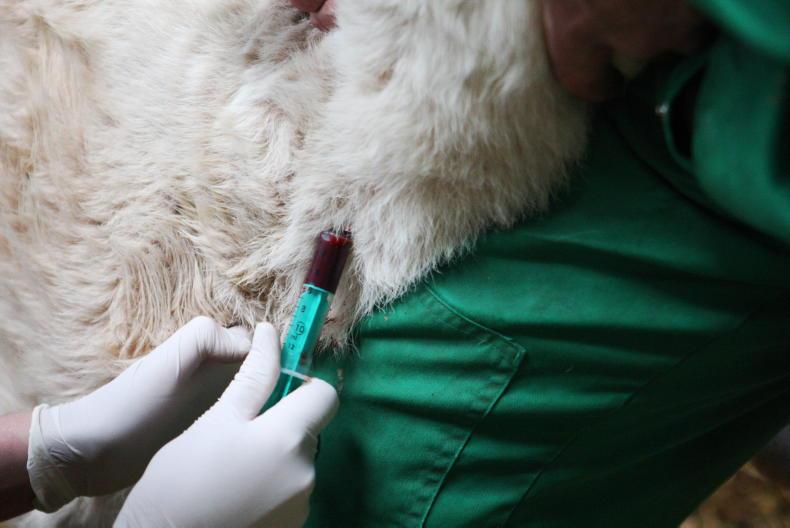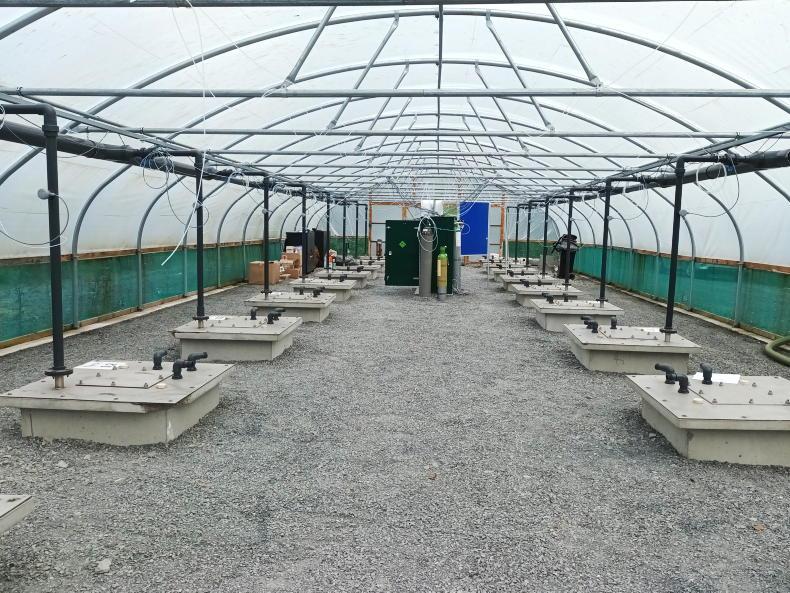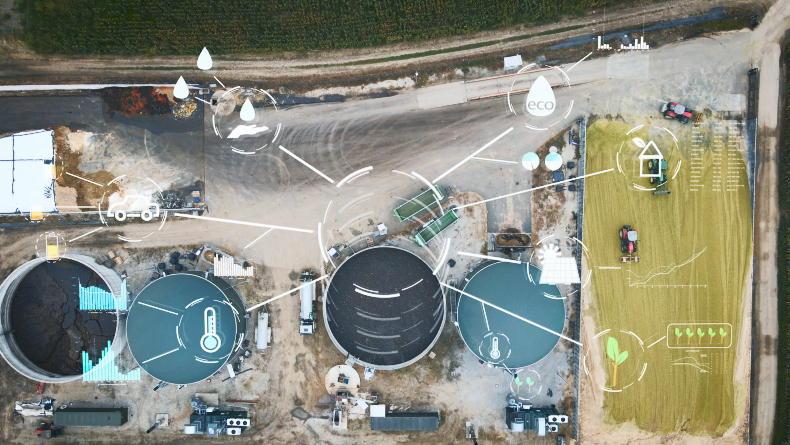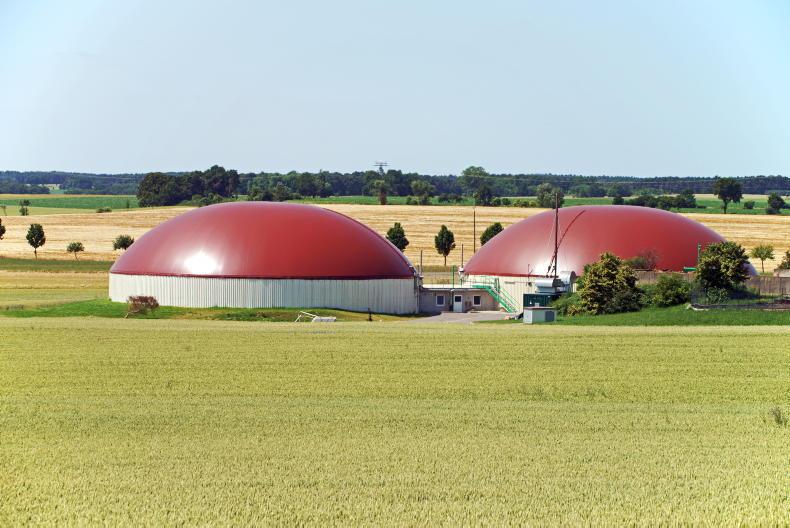Both nutrient pressure on water quality and the need for biomass to replace heating oil may be addressed by one crop particularly suited to Irish growing conditions: willow. Northern Ireland’s Agri-Food and Biosciences Institute (AFBI) has planted 5ha of the fast-growing woody plant on its Hillsborough research farm in Co Down, under the EU-funded Waterpro project.
Part of this land includes a foot of grassland hill bordering a stream. Scientist Chris Johnston showed the Irish Farmers Journal six test plots there – three 14m x 10m areas planted with willows, three of which are interspersed where the original grass runs all the way down the hill. Planted three years ago and cut back once, the plants are now taller than two people and some have woody trunks you can barely circle with one hand. Trenches dug across the bottom of the hill direct run-off water where its volume and nutrient loading is analysed at regular intervals.
“In time, we want to quantify whether the effect of the willow plantation actually has a positive response to the amount of nutrient and nutrient loading which could run off as a result of overland flow into our streams, rivers and lakes,” said Johnston. Initial results show that this is happening, but several more years will be needed to obtain verified results – especially after the unusual weather observed in 2018.
Under another EU project, Catchment Care, AFBI is also measuring the effect of willow on water quality on a 20ha area on the farm. Johnston and his colleagues used Lidar technology to scan the land in 3D and identify where the terrain was most likely to cause water run-off: corners of fields, ditches and hollows on the hilly farm.
“We’ve used those areas to plant willow plantations into, with the theory to prove that in time, we will see a reduction in overland flow into these streams and environmental water supply,” Johnston said. This is expected to occur as a result of the nutrient and water uptake of the willows, the rougher soil surface in the plantation and improved soil conductivity for water – “everything to try to prevent it running over land,” he added. Equipment can be seen pumping water through the soil within the plantation to see how easily it percolates and measure such conductivity.
The willows grown at Hillsborough are used to heat the farm and research centre, powering one of the three biomass boilers used at AFBI’s bioenergy centre. “On-farm here, we’ve been using willow plantations, residues, brash forestry and energy crops to displace the use of fossil fuel,” said Chris Johnston. “We distribute this around the farm in a 2.5km district heating system to the offices, the buildings, the dairy parlour.”
Willows are usually harvested with a self-propelled silage harvester, but Johnston is looking into cheaper, PTO-powered harvesters for small areas planted selectively around the farm.
Some of the heat is used to dry the willow chip and other biomass fuels produced on the farm. Johnston reckons the cost of producing heating fuel from willow at Hillsborough is 1.5p/kWh. While this does not cover land costs or the profit a farmer would need to make to grow the crop commercially, it still compares very favourably with heating oil at current prices.
Johnston said that interest in the bioenergy research conducted by AFBI was lower in Northern Ireland now that the Renewable Heat Incentive (RHI) scheme has closed.
However, there are lessons to be learned for the Republic, where the Support Scheme for Renewable heat has just opened to support users of biomass fuel.
Read more
Energy crops and wood fuels cheaper than oil
Willow strips can lower P run-off
Renewable heat scheme to benefit forestry
Both nutrient pressure on water quality and the need for biomass to replace heating oil may be addressed by one crop particularly suited to Irish growing conditions: willow. Northern Ireland’s Agri-Food and Biosciences Institute (AFBI) has planted 5ha of the fast-growing woody plant on its Hillsborough research farm in Co Down, under the EU-funded Waterpro project.
Part of this land includes a foot of grassland hill bordering a stream. Scientist Chris Johnston showed the Irish Farmers Journal six test plots there – three 14m x 10m areas planted with willows, three of which are interspersed where the original grass runs all the way down the hill. Planted three years ago and cut back once, the plants are now taller than two people and some have woody trunks you can barely circle with one hand. Trenches dug across the bottom of the hill direct run-off water where its volume and nutrient loading is analysed at regular intervals.
“In time, we want to quantify whether the effect of the willow plantation actually has a positive response to the amount of nutrient and nutrient loading which could run off as a result of overland flow into our streams, rivers and lakes,” said Johnston. Initial results show that this is happening, but several more years will be needed to obtain verified results – especially after the unusual weather observed in 2018.
Under another EU project, Catchment Care, AFBI is also measuring the effect of willow on water quality on a 20ha area on the farm. Johnston and his colleagues used Lidar technology to scan the land in 3D and identify where the terrain was most likely to cause water run-off: corners of fields, ditches and hollows on the hilly farm.
“We’ve used those areas to plant willow plantations into, with the theory to prove that in time, we will see a reduction in overland flow into these streams and environmental water supply,” Johnston said. This is expected to occur as a result of the nutrient and water uptake of the willows, the rougher soil surface in the plantation and improved soil conductivity for water – “everything to try to prevent it running over land,” he added. Equipment can be seen pumping water through the soil within the plantation to see how easily it percolates and measure such conductivity.
The willows grown at Hillsborough are used to heat the farm and research centre, powering one of the three biomass boilers used at AFBI’s bioenergy centre. “On-farm here, we’ve been using willow plantations, residues, brash forestry and energy crops to displace the use of fossil fuel,” said Chris Johnston. “We distribute this around the farm in a 2.5km district heating system to the offices, the buildings, the dairy parlour.”
Willows are usually harvested with a self-propelled silage harvester, but Johnston is looking into cheaper, PTO-powered harvesters for small areas planted selectively around the farm.
Some of the heat is used to dry the willow chip and other biomass fuels produced on the farm. Johnston reckons the cost of producing heating fuel from willow at Hillsborough is 1.5p/kWh. While this does not cover land costs or the profit a farmer would need to make to grow the crop commercially, it still compares very favourably with heating oil at current prices.
Johnston said that interest in the bioenergy research conducted by AFBI was lower in Northern Ireland now that the Renewable Heat Incentive (RHI) scheme has closed.
However, there are lessons to be learned for the Republic, where the Support Scheme for Renewable heat has just opened to support users of biomass fuel.
Read more
Energy crops and wood fuels cheaper than oil
Willow strips can lower P run-off
Renewable heat scheme to benefit forestry









SHARING OPTIONS